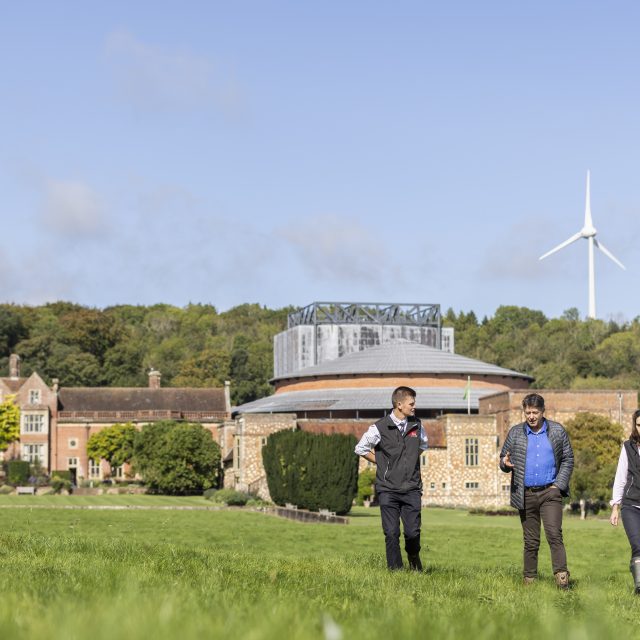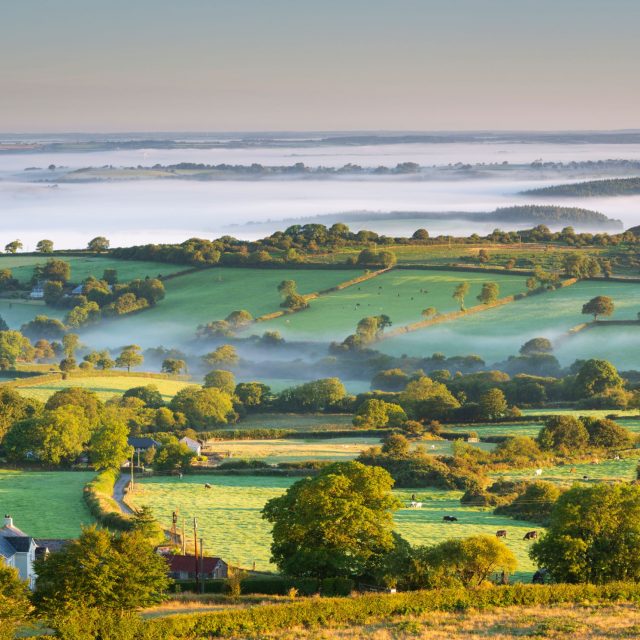In the know: How farms are becoming more climate resilient
Farming businesses across the UK face the prospect of warmer and wetter winters, hotter and drier summers and more frequent and intense weather extremes.
Recent Met Office figures show that average UK temperatures between 2014 and 2023 were 1.25°C higher than between 1961 and 1990 and six of the warmest years on record occurred in the most recent decade. Meanwhile, five of the 10 wettest years for the UK have also occurred since 2000.
Jonathan Armitage, Head of Farming for Strutt & Parker, says every farm has been affected by climate change and either ‘consciously or unconsciously’ farmers are responding to these impacts.
‘Often people start to do things differently because it has become too challenging to do something they may have done without issue for years,’ he says.
‘For instance, many farmers routinely drilled oilseed rape, confident that moisture would be available at the right time and the crop would survive the slugs or Cabbage Stem Flea Beetle (CSFB). There are several reasons why this is no longer the case, but underpinning them all is climate change.’
Jonathan says it can be helpful to distinguish between what is expected from land managers in terms of climate mitigation and climate adaptation.
‘Mitigation involves reducing greenhouse gas emissions and increasing carbon sequestration to limit further temperature rises. Adaptation is about adjusting farming operations to make your business more resilient in the event of adverse weather conditions. Both of these are essential, but the latter is arguably more pressing for future farm viability.’
Farmers are being encouraged to take a more strategic approach to improving
climate resilience as part of their planning for the future.
‘Some sectors – such as intensive pig and poultry – actually no longer have any choice as a climate change risk assessment is now mandatory as part of the environmental permitting regime.
‘However, a focus on climate resilience should be important to everyone as part of managing risk. We can’t control the weather, but we can plan to reduce exposure – both physically and financially – to more erratic weather patterns.’
Grants are available through schemes like the Sustainable Farming Incentive (SFI) in England and Scotland’s Agri-Environment Climate Scheme (AECS) to support making some of the changes that may be needed.
Jonathan points out that despite the uncertainties, UK farmers are probably in a better position than many globally.
‘However bad we think things are at times, the UK has some of the best farmland and a temperate climate with plenty of water compared to much of the world. We do have those advantages despite the challenges we are facing.’
5 TOP TIPS ON CLIMATE CHANGE ADAPTATION
Soil Health
Focus on protecting and enhancing soil health by reducing tillage, using cover crops, and increasing organic matter. This should help to increase water retention, improve fertility, reduce runoff and strengthen resilience against extreme weather events, supporting more consistent food production.
Water Management
Maintaining good land drainage has never been more important, so regular ditch maintenance and clearing of blocked outfalls should be a priority. When you take action to remove water from fields more rapidly it becomes more important to consider the potential for soil run-off and water pollution. The use of 3D buffer strips can be an effective way to reduce this. As water availability becomes a bigger issue, investing in efficient irrigation, on-farm reservoirs and rainwater harvesting systems will also be crucial for sustainable farming.
Spreading Risk
Consider ways to achieve greater diversity in cropping by widening rotations, utilising a wider range of varieties that also extend planting and harvesting windows or by using companion cropping or even blended varieties. Livestock farmers with access to arable land can mitigate feed market volatility by growing more of their own feed crops. Some farms may wish to rent additional grassland as a buffer in seasons when grass growth is hampered by dry weather.
Infrastructure
Planting trees and hedgerows will offer livestock shade and shelter, while installing additional surface water drains near buildings can prevent flooding during heavy rainfall. A network of well-built and maintained farm access tracks can be a huge advantage in getting work done in small weather windows. Good livestock housing, crop storage and handling facilities all provide resilience when the weather is against you. These may be difficult to justify on a straightforward return-on-investment basis, but as part of a risk management strategy they can be invaluable.
Machinery Policy
Weather extremes mean that growers may have a shorter window in which to plant or harvest their crops so having access to the right machinery at the right time becomes more valuable and should be factored into buying or leasing decisions.
Plans should be made for how to increase this resource at short notice if necessary. Collaboration between farmers is not only a way to share the total cost of machinery, but can also extend the range of options available to cope with varying conditions.
CASE STUDIES
DIVERSE THINKING
Hannah Darby, who farms 300ha in partnership with her uncle, Tony, on the Sawtry Fens, near Cambridgeshire, says they have made a series of changes to their farming practices over the past decade which collectively are helping in terms of climate resilience.
‘I wouldn’t say that some of the decisions we have made started with the objective of climate resilience. They were more because they made business sense, but I do think they mean we are now in a more resilient position than where we would have been.’
The farm started moving away from the plough in the early 2000s as a cost-saving measure. This has evolved into a minimal cultivations approach as they have come to appreciate the benefits for soil health.
‘We last did a big plough to bury blackgrass in 2015/16 and it had a really negative impact on our yields that year. Since then, we have pretty much consistently not done any tillage. We might still use some steel in areas of the field that are very compacted, but very sparingly, to lift, rather than invert the soil.’
Cover crops are being used across the farm which helps get natural drainage into the soil and keeps the soil in place.
‘We have very variable soil types ranging from peatland, with very high organic matter, through to clay. On the Fen we are using cereal cover crops to mop up any excess nitrogen and reduce losses to air and water. However, on the clay soils we are growing mixes with lots of different root types, including legumes, to add fertility.’
Hannah acknowledges that improving soil structure is not a silver bullet in terms of coping in the wet years – the benefits are more noticeable in times of drought.
However, the business has recently purchased a new digger so it can implement a more regular programme of ditch maintenance to improve drainage.
Another development over the past four years has been the introduction of companion cropping, with the farm growing either a combination of peas and beans or peas and oats.
‘We were struggling to successfully grow peas on the Fen because they were falling over because the soil is so high in nitrogen. I thought if we tried growing them mixed with oats it would provide some scaffolding and it has worked really well as growing the two crops together is also helping with weed control. We’re now getting more income from the same area of land.’
Hannah believes the farm is still very much ‘on the journey’ towards climate resilience. This year she will be once again growing a blend of three different wheat varieties, which – as with the companion cropping – helps to spread risk.
‘It is becoming hard to get the return on investment that was previously guaranteed by growing winter wheat in the conventional way. We’re finding in the past five years we’ve had more crop failures than ever before – for various reasons – and we have to find ways to mitigate that. But we can’t just have one good harvest in five years, we need to find ways to have an acceptable harvest every year.’
DRAINAGE IMPROVEMENTS
Tackling poor drainage has been made a top priority on a Lincolnshire farm over the past 12 months, to reduce the risk of a repeat of the horrifically wet conditions seen in autumn 2023.
Strutt & Parker has been involved with the business since 2023, when the farm was purchased by our client who is strongly motivated to improve the condition of the farm to increase agricultural productivity, as well as environmental outcomes.
‘It was evident that the previous occupier was suffering crop losses, with about a third of the 2023 potato crop rendered unharvestable because the ground became so waterlogged,’ says Rob Wilkinson, Strutt & Parker farm consultant in the Stamford office. ‘It was clear to everyone that action was required.’
The first step in the process was to carry out a comprehensive visual assessment of the 325ha farm, to pinpoint the fields most in need of drainage improvements.
The findings of this review were then combined with land quality data, enabling a targeted investment approach focused on the land parcels where the impact would be most significant.
‘At that stage, it seemed that the farm might need to invest as much as £150,000 on new drainage systems. However, before moving forward, we obviously wanted to make sure the ditch network had been adequately maintained,’ says Rob. ‘If you are going to funnel water off fields, you have to make sure there is somewhere for it to go.’
Throughout 2024, more than 31km of ditches have been cleared with thousands of
tonnes of spoil removed. This work revealed that some of the fields which had been earmarked for new drainage already have systems in place. However, the drains had not been operating efficiently due to a lack of maintenance.
‘We are now in the process of clearing any blocked outfalls and employing jetting techniques to clear any sediment where the drain itself looks to be blocked.’
The client remains committed to investing in some new drainage, but the amount of money that will need to be spent is now projected to be significantly lower than originally anticipated.
‘By improving the drainage infrastructure, we anticipate improvements to yields, soil health and a reduced risk of crop losses in the face of extreme weather conditions.’
This article first appeared in our latest issue of Land Business. It forms part of our ‘In the Know’ series which sees Strutt & Parker experts share insight and advice on how farms and estates can improve their business resilience, both from an economic and environmental perspective. For more download the Autumn/Winter 24 edition of Land Business.






